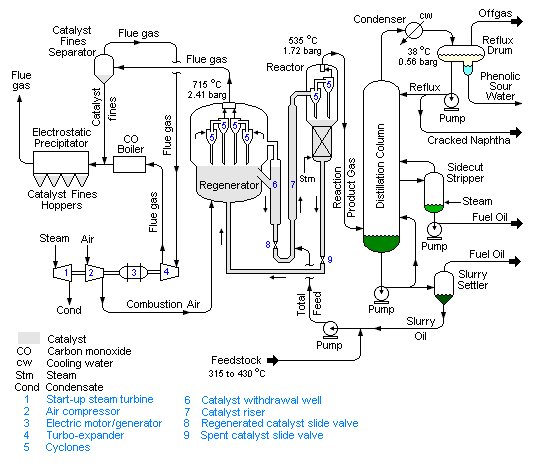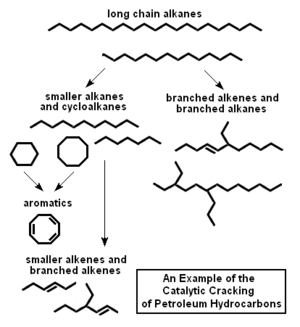User:Milton Beychok/Sandbox: Difference between revisions
Jump to navigation
Jump to search
imported>Milton Beychok mNo edit summary |
imported>Milton Beychok No edit summary |
||
| Line 1: | Line 1: | ||
The '''fluid catalytic cracker''' (FCC) is the most important conversion process unit used in petroleum refineries. It is widely used to convert the high-boiling hydrocarbon fuel oils in petroleum crude oils to more valuable gasoline and other products.<ref name=Gary>{{cite book|author=James H. Gary and Glenn E. Handwerk|title=Petroleum Refining: Technology and Economics|edition=4th Edition|publisher=CRC Press|year=2001|id=ISBN 0-8247-0482-7}}</ref><ref name=Speight>{{cite book|author=James. G. Speight|title=The Chemistry and Technology of Petroleum|edition=4th Edition|publisher=CRC Press|year=2006|id=ISBN 0-8493-9067-2}}</ref><ref name=Reza>{{cite book|author=Reza Sadeghbeigi|title=Fluid Catalytic Cracking Handbook|edition=2nd Edition|publisher=Gulf Publishing|year=2000|id=0-88415-289-8}}</ref> The feedstock to an FCC is usually that portion of the crude oil that has an initial boiling point of 330 °C or higher at atmospheric pressure. | |||
As of 2006, FCC units were in operation at 400 petroleum refineries worldwide and about one-third of the crude oil refined in those refineries is processed in an FCC to produce high-octane gasoline, diesel oil and fuel oil.<ref name=Speight/><ref name=Jones>{{cite book|author=David S.J. Jones and Peter P.Pujado (Editors)|title=Handbook of Petroleum Processing|edition=First Edition|publisher=Springer|year=2006|id=ISBN 1-4020-2819-9}}</ref> | |||
==Flow diagram and process description== | |||
[[Image:FCC.png|center|thumb|533px|{{#ifexist:Template:FCC.png/credit|{{FCC.png/credit}}<br/>|}}A schematic flow diagram of a Fluid Catalytic Cracking unit as used in petroleum refineries]] | |||
==Chemistry== | |||
[[Image:FCC Chemistry.png|right|thumb|300px|{{#ifexist:Template:FCC Chemistry.png/credit|{{FCC Chemistry.png/credit}}<br/>|}}The chemistry of catalytic cracking of petroleum hydrocarbons]] | [[Image:FCC Chemistry.png|right|thumb|300px|{{#ifexist:Template:FCC Chemistry.png/credit|{{FCC Chemistry.png/credit}}<br/>|}}The chemistry of catalytic cracking of petroleum hydrocarbons]] | ||
===Catalysts=== | |||
==History== | |||
==References== | |||
{{reflist}} | |||
Revision as of 11:42, 23 April 2008
The fluid catalytic cracker (FCC) is the most important conversion process unit used in petroleum refineries. It is widely used to convert the high-boiling hydrocarbon fuel oils in petroleum crude oils to more valuable gasoline and other products.[1][2][3] The feedstock to an FCC is usually that portion of the crude oil that has an initial boiling point of 330 °C or higher at atmospheric pressure.
As of 2006, FCC units were in operation at 400 petroleum refineries worldwide and about one-third of the crude oil refined in those refineries is processed in an FCC to produce high-octane gasoline, diesel oil and fuel oil.[2][4]
Flow diagram and process description
Chemistry
Catalysts
History
References
- ↑ James H. Gary and Glenn E. Handwerk (2001). Petroleum Refining: Technology and Economics, 4th Edition. CRC Press. ISBN 0-8247-0482-7.
- ↑ 2.0 2.1 James. G. Speight (2006). The Chemistry and Technology of Petroleum, 4th Edition. CRC Press. ISBN 0-8493-9067-2.
- ↑ Reza Sadeghbeigi (2000). Fluid Catalytic Cracking Handbook, 2nd Edition. Gulf Publishing. 0-88415-289-8.
- ↑ David S.J. Jones and Peter P.Pujado (Editors) (2006). Handbook of Petroleum Processing, First Edition. Springer. ISBN 1-4020-2819-9.

